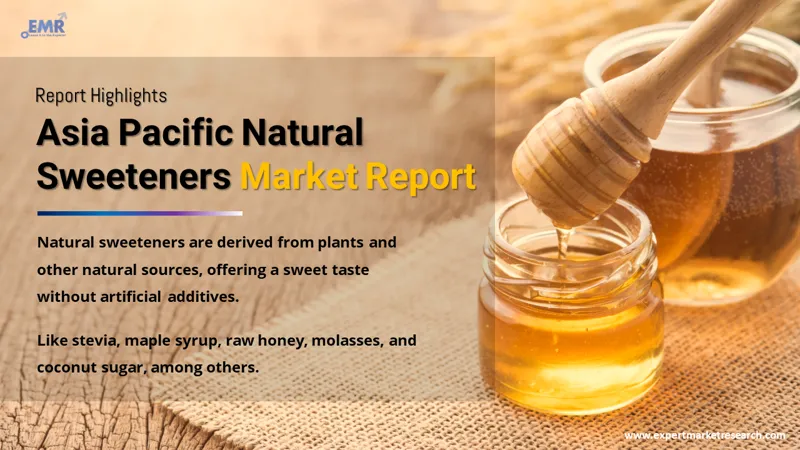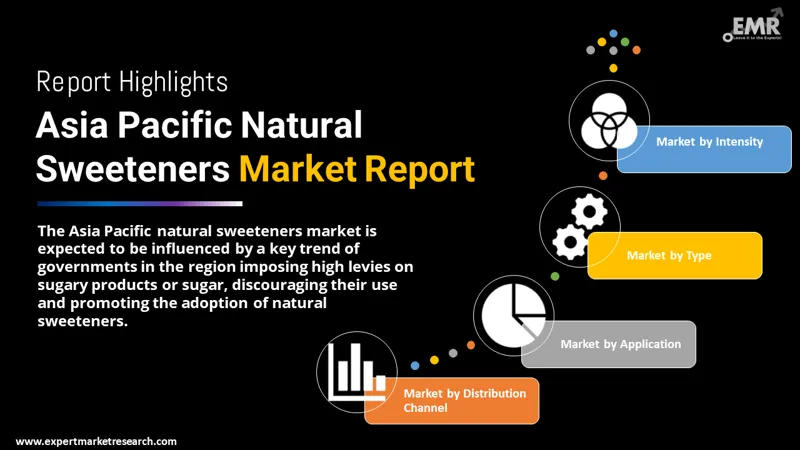
Consumer Insights
Uncover trends and behaviors shaping consumer choices today
Procurement Insights
Optimize your sourcing strategy with key market data
Industry Stats
Stay ahead with the latest trends and market analysis.
The Asia Pacific natural sweeteners market reached a value of USD 13.58 Billion in 2025 and is expected to grow at a CAGR of 7.30% during 2026-2035 to reach a value of USD 27.47 Billion by 2035.
Base Year
Historical Period
Forecast Period
Compound Annual Growth Rate
7.3%
Value in USD Billion
2026-2035
*this image is indicative*
The Asia Pacific is the amongst the leading regions in the stevia industry, accounting for about 87% of the world’s total stevia production. China is the major producer of stevia in the region, accounting for about 91% of the total stevia production in the Asia Pacific. China has a huge consumer base which contributes to its domestic market whereas the increasing demand for stevia across the different parts of the world provides a boost to its overseas market as China is a major exporter of stevia. Japan is one of the leading consumers of stevia. Stevia accounts for almost 40% of the total sweeteners market share in Japan. Stevia contains up to 200 times the sweetness of sugar and, thus, is being widely incorporated into leading soft drinks such as Pepsi True and Coca Cola Life along with baked goods, candies, and other food products.

Read more about this report - REQUEST FREE SAMPLE COPY IN PDF
Latin America and North America are also emerging as the significant stevia markets, globally. The stevia demand is these regions have been driven by the increasing number of health-related problems like diabetes and obesity. The governments in the two regions are also condemning the use of sugar to control the increased number of health issues, which is further aiding the market. The food and beverage companies are also preferring natural sweeteners over artificial ones to meet the rising consumer demand for natural and low-calorie sweeteners. In Latin America and North America, the natural sweeteners find its maximum application in soft drinks while sports nutrition and dairy are the other leading sectors in the regions.
Natural sweetener refers to a sweetener, which occurs naturally in plants and in other sources, rather than being prepared in a lab. They can be categorised as stevia, maple syrup, raw honey, molasses, and coconut sugar, among others.
Market Breakup by Intensity
Market Breakup by Type
Market Breakup by Application
Market Breakup by Distribution Channel
Market Breakup by Region

Read more about this report - REQUEST FREE SAMPLE COPY IN PDF
The Asia Pacific natural sweeteners industry is being driven by the rising health concern among the consumers, resulting in an increased demand for the healthy products. As the consumers have become more health-conscious, the demand for drinks with low sugar and low-calorie content has increased. Thus, producers are opting for low-calorie and efficient alternatives for sugar like stevia, further propelling the Asia Pacific natural sweeteners industry forward.
The food and beverage sector has seen a healthy growth in the region, which is also aiding the growth of the Asia Pacific natural sweeteners industry. The companies are preferring natural sweeteners over the artificial ones to meet the growing demand for healthier products. More than 5,000 food and drink products now contain steviol glycosides (an active compound of stevia). It was estimated that steviol glycosides have the potential to replace about 30% of all dietary sweeteners in the coming years.
Globally, the natural sweeteners industry is being driven by the growing incidences of lifestyle and sugar-related diseases. In Latin America and North America, the use of natural sweeteners has increased due to the rise in the cases of diabetes and obesity among the people, thus, driving the industry further. In 2016, 30.3 million Americans or 9.4% of the population was diagnosed with diabetes, which is further growing by 1.5 million every year. The governments in the regions is also condemning the use of sugar by applying high levies on sugary products or sugar. Countries like Mexico and U.S. are contributing to the growth of the natural sweeteners industry by producing and exporting non-alcoholic beverages.
The report gives a detailed analysis of the following key players in the Asia Pacific market for natural sweeteners, covering their competitive landscape, capacity, and recent developments like mergers and acquisitions, investments, capacity expansion, and plant turnarounds:
The EMR report provides an in-depth analysis of the industry based on SWOT and Porter’s five forces analysis.




*While we strive to always give you current and accurate information, the numbers depicted on the website are indicative and may differ from the actual numbers in the main report. At Expert Market Research, we aim to bring you the latest insights and trends in the market. Using our analyses and forecasts, stakeholders can understand the market dynamics, navigate challenges, and capitalize on opportunities to make data-driven strategic decisions.*
Get in touch with us for a customized solution tailored to your unique requirements and save upto 35%!
The Asia Pacific natural sweeteners market reached a value of USD 13.58 Billion in 2025.
The Asia Pacific natural sweeteners market is expected to grow at a CAGR of 7.30% during 2026-2035.
The market is estimated to reach a value of USD 27.47 Billion by 2035.
The major market drivers include rising disposable incomes, increasing population, growing health concerns, the flourishing food and beverage sector, and the rising prevalence of health issues like diabetes.
The introduction of stringent regulations such as sugar taxes to reduce the usage of sugar in food and beverages by governments is expected to be a key trend guiding the growth of the market.
China, Japan, India, ASEAN, and Australia, among others, are the leading countries in the market.
The major intensity segments of natural sweeteners considered in the market report include high intensity sweeteners and low intensity sweeteners.
The leading types of the product in the market include stevia, maple syrup, raw honey, molasses, and coconut sugar, among others.
The significant application segments in the market are food, beverages, pharmaceuticals, and personal care, among others.
The major distribution channels in the market include hypermarket and supermarket, convenience stores, retail stores, and online retailers, among others.
The key players in the market are PureCircle Limited, Tate and Lyle Plc, Cargill Inc., Archer Daniels Midland Company, Ingredion Incorporated, SteviaPac Food Innovation, Layn Corp., Zhucheng HaoTian Pharm Co., Ltd, and Sunwin Stevia International, Inc., among others.
Explore our key highlights of the report and gain a concise overview of key findings, trends, and actionable insights that will empower your strategic decisions.
| REPORT FEATURES | DETAILS |
| Base Year | 2025 |
| Historical Period | 2019-2025 |
| Forecast Period | 2026-2035 |
| Scope of the Report |
Historical and Forecast Trends, Industry Drivers and Constraints, Historical and Forecast Market Analysis by Segment:
|
| Breakup by Intensity |
|
| Breakup by Type |
|
| Breakup by Application |
|
| Breakup by Distribution Channel |
|
| Breakup by Region |
|
| Market Dynamics |
|
| Competitive Landscape |
|
| Companies Covered |
|
| Report Price and Purchase Option | Explore our purchase options that are best suited to your resources and industry needs. |
| Delivery Format | Delivered as an attached PDF and Excel through email, with an option of receiving an editable PPT, according to the purchase option. |
Datasheet
One User
USD 2,499
USD 2,249
tax inclusive*
Single User License
One User
USD 3,999
USD 3,599
tax inclusive*
Five User License
Five User
USD 4,999
USD 4,249
tax inclusive*
Corporate License
Unlimited Users
USD 5,999
USD 5,099
tax inclusive*
*Please note that the prices mentioned below are starting prices for each bundle type. Kindly contact our team for further details.*
Flash Bundle
Small Business Bundle
Growth Bundle
Enterprise Bundle
*Please note that the prices mentioned below are starting prices for each bundle type. Kindly contact our team for further details.*
Flash Bundle
Number of Reports: 3
20%
tax inclusive*
Small Business Bundle
Number of Reports: 5
25%
tax inclusive*
Growth Bundle
Number of Reports: 8
30%
tax inclusive*
Enterprise Bundle
Number of Reports: 10
35%
tax inclusive*
How To Order

Select License Type
Choose the right license for your needs and access rights.

Click on ‘Buy Now’
Add the report to your cart with one click and proceed to register.

Select Mode of Payment
Choose a payment option for a secure checkout. You will be redirected accordingly.
Gain insights to stay ahead and seize opportunities.

Get insights & trends for a competitive edge.

Track prices with detailed trend reports.

Analyse trade data for supply chain insights.

Leverage cost reports for smart savings

Enhance supply chain with partnerships.

Connect For More Information
Our expert team of analysts will offer full support and resolve any queries regarding the report, before and after the purchase.
Our expert team of analysts will offer full support and resolve any queries regarding the report, before and after the purchase.
We employ meticulous research methods, blending advanced analytics and expert insights to deliver accurate, actionable industry intelligence, staying ahead of competitors.
Our skilled analysts offer unparalleled competitive advantage with detailed insights on current and emerging markets, ensuring your strategic edge.
We offer an in-depth yet simplified presentation of industry insights and analysis to meet your specific requirements effectively.
Share